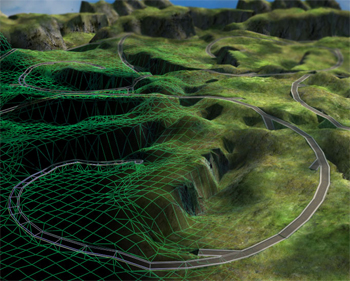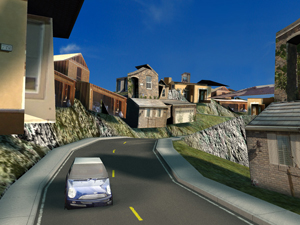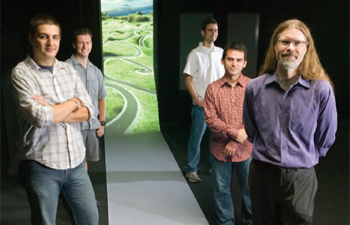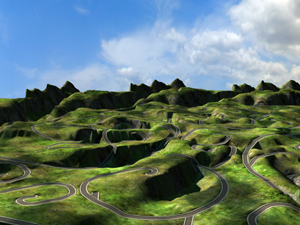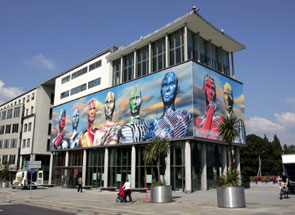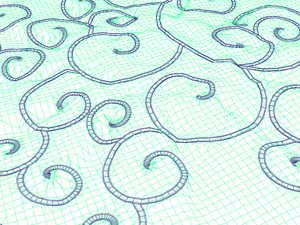Calit2 Artist to Unveil Interactive Exhibit at World-Famous Digital Media Festival
By Doug Ramsey, 858-822-5825, dramsey@ucsd.edu
|
San Diego, CA, August 27, 2006 -- Calit2’s artist in residence at UCSD, Sheldon Brown, is in Austria this week to oversee the installation and opening of his interactive multimedia piece Scalable City at Ars Electronica Center, one of the world’s leading museums of digital and media art.
The August 30 opening in Linz will be one of the highlights of the annual Ars Electronica Festival. Brown, the director of UCSD’s Center for Research in Computing and the Arts (CRCA), will deliver a presentation during the Festival, but when the hoopla is over, Scalable City will settle in for a long run at the museum—at least 12 months, and up to two years.
“In all the interactive work I do, ‘I won’ or ‘I made it to the next level’ is not the achievement I’m trying to engender,” says the Visual Arts professor. “My goal is to get people to move into a more self-aware way of participating in the environment.”
|
The Scalable City has been shown in various forms at venues from New York to Poland. "Those were digitally produced prints, procedural animations and even a sculpture that drew on elements from the same data and asset pool," notes Brown. "For Ars Electronica, I've made a unique version of the project to work with the exhibition environment at the museum."
The basic concept of Scalable City derives from the incredibly dense databases produced by geographic information systems," he adds. "Our program uses that data as seeds for virtual experiences that use visual, aesthetic methods to engage viewers in a deeper way."
The new version is certainly interactive. It will be displayed on a three-screen environment. Although many people can view the action, one person navigates the virtual environment at a time. "You navigate through the Scalable City with a track ball and button built into a polygonal artifact that is a sculptural object built from fragments of data used in the piece," explains Brown.
Scalable City was developed by Brown and a small cadre of graduate and undergraduate students in Atkinson Hall’s Experimental Game Lab. The team is interdisciplinary—half coming from visual arts, and half from computer science. Lab manager Alex Dragulescu coordinated work on the project while also programming and developing assets. Visual Arts graduate student Michael Caloud developed the inverse kinematic (IK) system, which takes moving objects from their initial state to a goal state and defines the parameters for how those objects can move. Another Visual Arts grad student, Carl Burton, developed the 3D models.
|
Three Computer Science and Engineering graduate students play key roles in the project. Joey Hammer was the 'buildmaster' on Scalable City -- making him responsible for tying the various subsystems into a single software framework. "How does rendering communicate with IK? Or with the physics? That's what Joey had to deal with," says Brown. Erik Hill separately took an algorithm for plant growth and applied it to the road construction. The physics were handled by Daniel Tracy. "For a game system, we have a lot of simultaneous dynamic systems that have to be coordinated," observes Sheldon Brown. "It's a big stretch because we have to see how many systems we can keep as dynamic elements, knowing full well that more systems make the program computationally more challenging."
Unlike standard computer games, there is no goal in Scalable City, and users don't amass points. But, admits Brown, "there is one condition in the environment where you'll reach a particular state that we like. You reach different levels of aesthetic clarity to the environment, different moments of understanding as to what these systems might be. And when you experience one of these things, you may go from the functional understanding of the cause and effect, to a more observational or appreciative state, while finally ending up in a more reflective, participatory state."
Adds Brown: "You ask yourself, why is this happening? What is it adding up to?"
|
Scalable City is open-ended, with an evolving structure and no built-in time limit. But Brown believes two minutes with the piece will provide enough of a participatory experience to allow attendees to "reach some of these transcendent states I'm hoping to get them to."
Staging an interactive project in a museum presents unique challenges. "When I build a piece like this for a museum, I take into account that museum-goers have several levels of engagement, from being a viewer of a situation to being an active participant," he says. "The user becomes an aesthetic element in the piece and others in the space become external viewers able to appreciate the action and narrative on their own terms. Both types of viewing are viable ways to appreciate the work."
|
The Ars Electronica Festival runs from August 31 through September 5. The Scalable City exhibit opens on August 30 and will be on display through at least August of 2007.
Related Links
Center for Research in Computing and the Arts
Scalable City
Ars Electronica Festival
Ars Electronica Center


